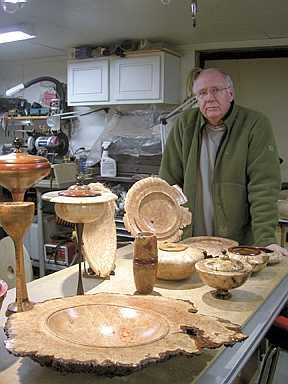Local artist Gary Travis wears several hats. Soon he’ll be turning them.
The 53-year-old has spent the past 15 years at
IPFW as the university’s graphic design
specialist and illustrator. Four years ago his
job expanded to include the role of Visual Arts
Gallery coordinator, and some two years ago he
donned additional titles as adjunct instructor,
teaching Design Fundamentals, as well as that of
safety director for the wood and metal shops.
To find him during off hours, look in his
cramped but ergonomically correct backyard studio
on the city’s northeast side. There he houses a
Canadian-made, state-of-the-art lathe and
assorted power tools with which he romances wood
of all sorts. Within the coming weeks Travis is
set to begin turning wooden hats (really) of his
own design.
For several years Travis has turned an
assortment of wonderfully wrought wooden
sculptures, bowls, vessels and spindles while
honing his craft to a level that pushes the
definition of mere decorative art toward more
challenging sculptural forms.
“What we’re witnessing is a similar evolution
that occurred over the last decade or so when
Dale Chihuly brought recognition to artisans
working in glass,” explained the staccato
speaking Travis. “A blurring of ‘craft’ and ‘fine
art’ in wood turnery. It is a really exciting
time, and I consider myself fortunate to be a
small part of it.
“I’m absorbed with both the beauty and mystery
of the wood and the process of discovering old
ways and inventing new techniques for working
with it. Even with several years behind me, I
still consider myself a learner.”
Travis initially sought to launch himself in a
career as a painter when he first enrolled at the
former Fort Wayne Art Institute. He’d been born
with an innate talent for brushwork and graphic
exactness, but there existed within him an
undercurrent of interest in sculpture. After a
period of studies that left him unfulfilled he
dropped out of the classroom and launched a
career in commercial graphic arts and sign
making.
For years he worked at his own studio in a space
adjacent to Henry’s on Main Street and
successfully earned a living in the classic mode
of a journeyman sign painter.
“Actually it worked out reasonably well for me,
but I could see the ‘handwriting on the wall,’ as
it were, with the introduction of vinyl signage
and computer technology so I made the decision to
take a position with the university where I
eventually finished my degree, and these other
opportunities just followed,” Travis recalled.
“I’d always been good with my hands, building
things, working as a carpenter and learning
tricks from an uncle and I craved the
satisfaction one gets from hewing objects out of
raw material, feeling texture and substance. I
really just stumbled into the woodturning realm
by accident and its been rewarding.”
Travis’ admirable pieces emerge from a variety
of woods, and they are no accident. Some are
formed from exotic stocks imported from Asia,
Australia, Africa and elsewhere, while others are
scavenged from local sites. Often local sources
are shared through a grapevine of “brother” wood
artists who find caches of naturally downed trees
as well as those harvested from the spoils of
ongoing urban expansion. (A century and one-half
ago Indiana was home to the largest stand of
hardwood forest on the continent.)
Burls – those often flattened hemispherical
outgrowths found on trees – provide perfect, if
difficult, fodder for turning bowls, wall
hangings and furniture parts. As the gnarly bark
is peeled away on the lathe the unpredictable
grain pattern is exposed giving fuel for the
turner’s imagination.
Sometimes the raw materials contain Swiss
cheese-like pockets of void. Other woods when
finished reveal a kind of marbled surface
composed of embedded debris and fungi. In many
cases working with such materials can be
dangerous to the turner. Chunks of the fragile
wood can be propelled toward the operator and
unknowingly piercing a vein of fungi, causing it
to spew into the air, can be hazardous to one’s
lungs. (Kids, don’t try this at home.)
Travis has come to understand the properties of
many types of wood: moisture content (he
sometimes uses his microwave to dehydrate certain
pieces), flexibility, density and warping
qualities. In some recent work he has joined
contrasting woods in a single piece with a result
that highlights specific traits innate to
distinct stock.
Travis finds that people are drawn to his work
in part because “my pieces are gentle, convey a
human touch and sensitivity. At the same time I
notice the reaction they elicit transcends skill
and medium and a connection is made to the spirit
and heart of the maker.”
So, too, has been the experience of this writer.
Travis is quick to point out the debt he owes to
his mentors over the years and suggests that any
interested parties follow the links on
www.woodturner.org. The local connection is
through Chiselers and Turners of NE Indiana. The
chapter holds an annual Woodfest where craftsmen
give lectures and demonstrations. This years
event is scheduled for March 5 at the Allen
County Sheriff’s Reserve on Easterday
Road.
 Submit Your Event
Submit Your Event
